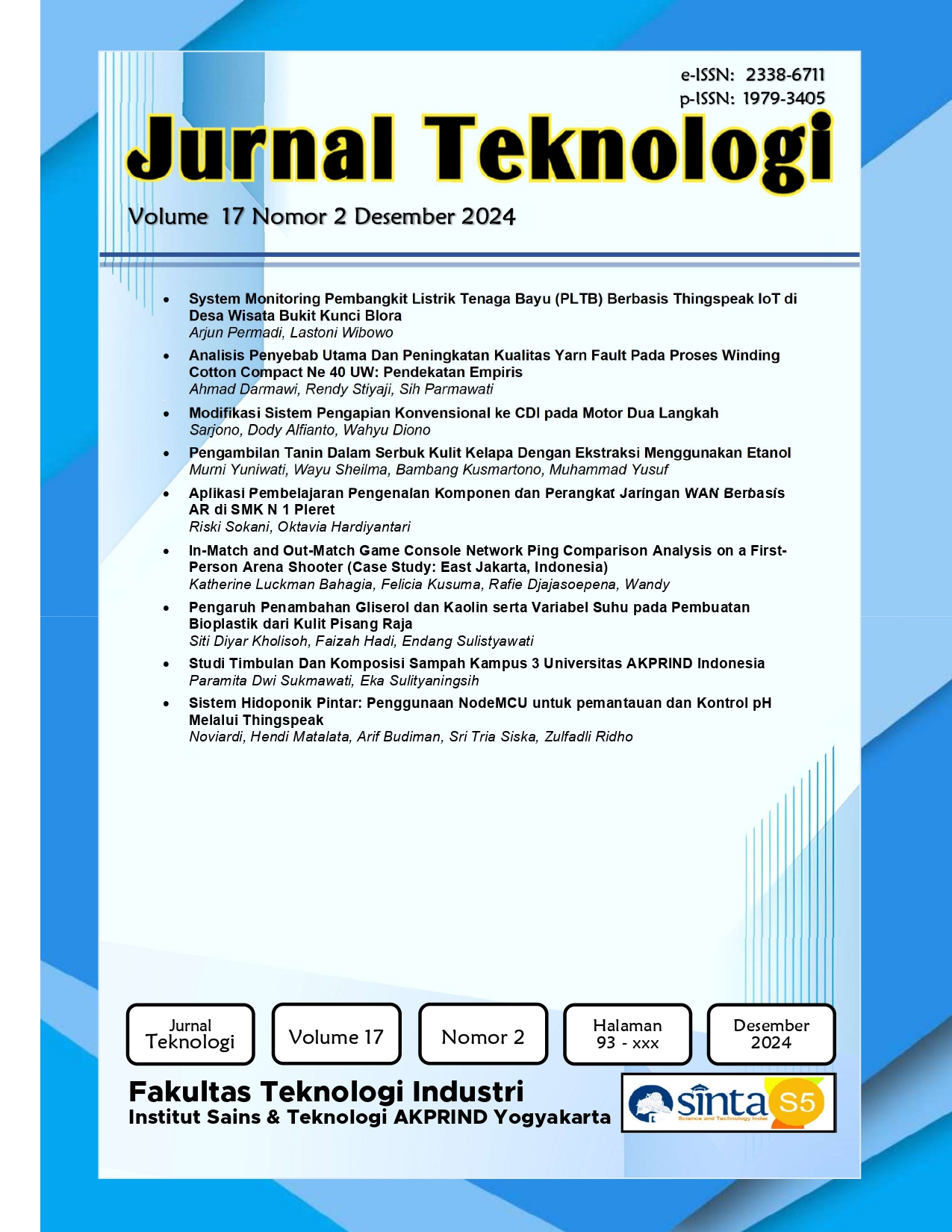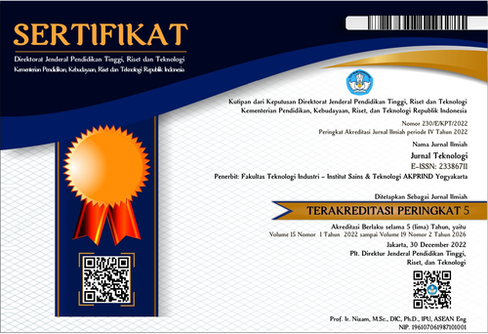Studi Timbulan dan Komposisi Sampah Kampus 3 Universitas AKPRIND Indonesia
DOI:
https://doi.org/10.34151/jurtek.v17i2.5131Keywords:
waste composition, waste generation, waste managementAbstract
Waste management is a critical issue faced by many institutions, including universities. AKPRIND University Indonesia, as an educational institution, has a large population, including students, teaching staff, and employees, who generate waste every day. Studies on waste generation and composition on campus are important for understanding waste production patterns and for designing effective and sustainable management strategies. The lack of accurate data on waste generation and composition often becomes an obstacle in formulating effective waste management policies. Therefore, the aim of this research is to gather data on waste generation, waste composition, and to provide recommendations for effective waste management. The research method includes calculating the amount of waste generated based on the weight and volume of the waste, then sorting the waste by type to determine the weight of each type of waste. The results of this study show an average total waste weight of 14.80 kg, an average total waste volume of 0.23 m3, and the most common types of waste are plastic waste at 7.36 kg, organic waste at 4.42 kg, paper waste at 1.43 kg, and other waste at 0.85 kg. The results of the waste generation data and waste composition are used to formulate waste management recommendations at Campus 3 of Universitas AKPRIND Indonesia, including: the need for policies from the University Leadership regarding efforts to reduce plastic waste, proper waste sorting, processing of organic waste by utilizing it for Black Soldier Fly (BSF) larvae cultivation, recycling of plastic waste, and the suggestion to establish a Waste Management.
Downloads
References
Alshuwaikhat, H. M., & Abubakar, I. (2008). An integrated approach to achieving campus sustainability: assessment of the current campus environmental management practices. Journal of Cleaner Production, 16(16), 1777–1785. https://doi.org/https://doi.org/10.1016/j.jclepro.2007.12.002
Damanhuri, E. dan T. P. (2010). “Pengelolaan Sampah Institusi.” Academia.
Fitria, R., Samadikun, B. P., & Priyambada, I. B. (2016). Studi timbulan, komposisi dan karakteristik dalam perencanaan pengelolaan sampah Universitas Diponegoro studi kasus: Fakultas Psikologi dan Fakultas Kesehatan Masyarakat. Diponegoro University.
Ishak, N., Mahayuddin, S. A., & Mohamed, M. R. (2015). Generation and Composition of Solid Waste in University Campus (pp. 119–126). https://doi.org/10.1007/978-981-4585-45-3_13
Laura, A. C. (2024). Analisis Komposisi Sampah Sebagai Dasar Pemilihan Metode Pengelolaan Sampah pada Green Building Restu Hikmah Ayu Murti. Populer: Jurnal Penelitian Mahasiswa, 3(1), 167–175.
Lembaga Penelitian dan Pengabdian Kepada Masyarakat Universitas Lampung. (2018). Pusat Penelitian dan Pengembangan Lingkungan Hidup. 2018. Studi Timbulan dan Komposisi Sampah Kampus Universitas Lampung. Lembaga Penelitian dan Pengabdian Kepada Masyarakat Universitas Lampung. Bandar Lampung.
Nasional, B. S. (1994). SNI 19-3964-1994 tentang Metode pengambilan dan pengukuran contoh timbulan dan komposisi sampah perkotaan. Departemen Pekerjaan Umum, Jakarta.
Rossariawari, F., & Mirwan, M. (2023). Perencanaan Teknik Operasional Pengelolaan Sampah Kampus UPN “ VETERAN ” Jawa Timur. Jurnal Pengabdian Masyarakat (Environation) (Environmental Engineering Journal of Communit Dedication, 3(2), 1–8.
Tangwanichagapong, S., Nitivattananon, V., Mohanty, B., & Visvanathan, C. (2016). Greening of a campus through waste management initiatives Experience from a higher education institution. International Journal of Sustainability in Higher Education, 18(2), 203–217. https://doi.org/10.1108/IJSHE-10-2015-0175
Tchnobanoglous, G. (1993). Integrated Solid Waste Management, Mc. Graw Inc, New York.
UU No 18 Tahun, 2008. (2008). Undang-undang No. 18 Tahun 2008 Tentang Pengelolaan Sampah.
Wahyuningtyas, D., Sukmawati, P. D., Nurcahyo, R. W., Hariyanto, S. D., Sulistyaningsih, E., Rahayu, S. S., & Yusuf, M. (2023). Penerapan Teknologi Pembiakan Larva Black Soldier Fly Untuk Optimalisasi Pengelolaan Sampah Organik Di Kalurahan Panggungharjo. DHARMA BAKTI, 200–209.
Wardiha, P. &. “Teknik Pengukuran Timbulan Sampah Dan Metode Analisisnya by Made Widiadnyana Wardiha Pradwi Sukma Ayu Putri (zLib.Org).Pdf” ed. Irwan Kurniawan (2020).
Widiarti, I. W., Anasstasia, T. T., Arih, F. C., Fairus, J. R. P., Khauroun, N. U., & Ulima, N. (2022). Studi Timbulan , Komposisi dan Karakteristik Sampah Institusi di UPN “ Veteran ” Yogyakarta. Jurnal Mineral, Energi Dan Lingkungan, 6(1), 19–26.
Yogyakarta, P. D. K. (2022). Peraturan Daerah Kota Yogyakarta Nomor 1 Tahun 2022 Tentang Perubahan Atas Peraturan Daerah Kota Yogyakarta Nomor 10 Tahun 2012 Tentang pengelolaan Sampah.
Downloads
Published
How to Cite
Issue
Section
License
Copyright (c) 2024 Paramita Dwi Sukmawati, Eka Sulityaningsih

This work is licensed under a Creative Commons Attribution-ShareAlike 4.0 International License.
Jurnal Teknologi provides immediate open access to its content in order of making research freely available to the public to support a global exchange of knowledge. All articles published in this journal are free for everyone to read and download, under licence CC BY SA.
Benefits of open access for the author, include:
- Free access for all users worldwide.
- Authors retain copyright to their work.
- Increased visibility and readership.
- No spatial constraints.




















